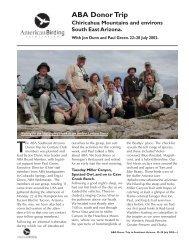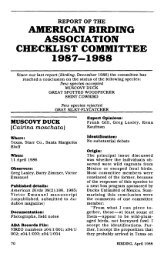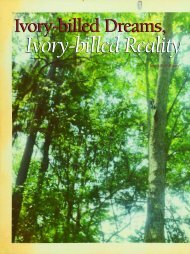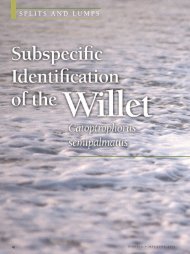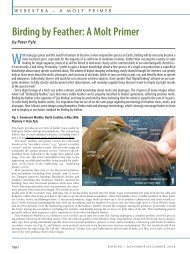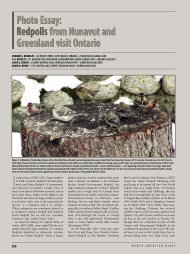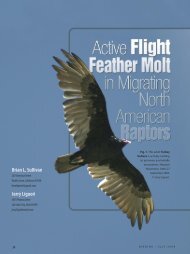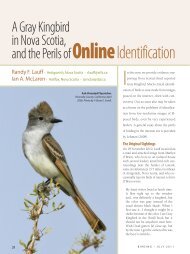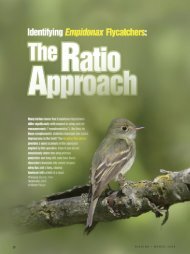Front End - American Birding Association
Front End - American Birding Association
Front End - American Birding Association
Create successful ePaper yourself
Turn your PDF publications into a flip-book with our unique Google optimized e-Paper software.
ment. It was obvious that calm or favorable winds overnight allowed migrants from<br />
Saturday’s flight to continue northward. The following new species were added over<br />
our hour and some stay: Least Flycatcher, Philadelphia Vireo, Bank Swallow,Veery, Bluewinged,<br />
Golden-winged, Chestnut-sided, Myrtle, Black-throated Green, Blackpoll, and<br />
Cerulean warblers, Ovenbird, and Northern Waterthrush. The Cerulean Warbler was a<br />
brilliant blue male and our last new bird before heading west was a female Blue-winged<br />
Warbler. One unexpected sight while at Peveto was a flyover White-tailed Kite slowly<br />
making its way east.<br />
It was tough to pull ourselves away from the woods as more and more migrants were<br />
making landfall, but there was a short list of “can’t miss” species that we desperately<br />
wanted to reduce. However in retrospect, leaving the woods may have been a lousy<br />
decision, as we added only three new species by Sabine Pass: Belted Kingfisher, Cliff<br />
Swallow, and Green-winged Teal. The Cave Swallows had not been reported at the<br />
Sabine Pass Bridge all spring.<br />
With plenty of daylight remaining we rushed back to Holly Beach searching high and<br />
low for anything that could be a new bird.A quick stop in Johnson Bayou revealed that<br />
small waves of migrants were arriving off the Gulf, and despite some searching we<br />
couldn’t buy a new species. With the fading light, many of the new arrivals were difficult<br />
to get on after they had reached the cover of the trees. We opted out of entering<br />
Peveto Beach Woods again for a second look at Holly Beach. A peculiar addition west<br />
of Holly Beach was a Yellow-bellied Flycatcher that was seen well flying in off the Gulf<br />
just a few feet above the ground. The increasing north wind had slowed its forward<br />
progress just enough to solidly identify it in flight as it crossed the road.<br />
We checked the Holly Beach water tower one last time; still no falcon. We kept a<br />
close eye on the marsh and utility poles as we drove north on LA-27. Several possibilities<br />
remained, but as the sky darkened they turned further into impossibilities.We made<br />
one last ditch effort for Great Horned Owl in Carlyss - nothing.<br />
By 2100, we were out of time, Charlie and Terry had to get back to Shreveport that<br />
night. We tallied the checklist for the first time all day. We were one short of the previous<br />
April Big Day record with 208 species. Running through the list of species that we<br />
missed was depressing, but we had to admit it was a satisfying first try. I think we’ll refine<br />
the route and try again some April…<br />
MAINE #1 – 30 Mar 08- 0730 to 1730 – Species Totals 58/58; (Team/Shared): Frank<br />
Paul, Jr. 58. 70 Miles by car, 1 mile by foot. Visiting: Two Lights area – Cape Elizabeth,<br />
Scarborough Marsh, Biddeford Pool. Species of note: none.<br />
MAINE #2 – 28 May 08- 0400 to 2200 – Species Totals 118/118; (Team/Shared): Bob<br />
Milardo 118, Bruce Barker 118, Judy Kellogg Markowsky 118. 250 Miles by car, 2 miles<br />
by foot. Visiting: Greater Bangor Area, Mount Desert Island. Species of note: Merlin (R),<br />
Field Sparrow (R),Virginia Rail (M), Laughing Gull (M), Hairy Woodpecker (M), Cliff Swallow<br />
(M).<br />
Comments: This was the team’s 24 th annual Big Day.<br />
MARYLAND – 31 Aug 08- 0000 to 1900 – Species Totals 151/146; (Team/Shared): Ron<br />
Gutberlet 149, Bill Hubick 149, Mikey Lutmerding 150. 310 Miles by car, 1 mile by foot.<br />
Visiting: Pickering Creek, Elliott Island Road, Bayside at Assateague, Assateauge ORV<br />
Zone, west OC Pond, Berlin, Nassawango area, Hurlock Tanyard Marsh. Species of note:<br />
Red-shouldered Hawk (M), Baird’s Sandpiper (R), Least Tern (L),Acadian Flycatcher (M),<br />
Eastern Phoebe (M), Louisiana Waterthrush (L), Song Sparrow (M),Western Meadowlark<br />
(V). Comments: Our Western Meadowlark was the first record for Delmarva, is expected<br />
to be second accepted record for Maryland, and is the first individual documented by<br />
photo and video in Maryland.<br />
It’s midnight beside the Pickering Creek ponds in Talbot County and our August Big<br />
Day has just officially begun. I’m standing in the dark with Jim Brighton, Mikey Lutmerding,<br />
and Ron Gutberlet, and we’re hoping to find 160 bird species over the next 24<br />
hours. Our goal is to beat the record of 159 species set by Jim Stasz, Ed Boyd, Matt<br />
Hafner, and Zach Baer.The night is calm, and the lack of wind is promising for nightbirds.<br />
It’s exciting. Canada Geese are honking nearby - one down. A minute passes quietly.<br />
Soon we detect a distant Barred Owl calling, and then another nearby. Fortune smiles<br />
upon us and a Sora calls spontaneously. I miss it and cost us our first 5% bird. We listen<br />
for another couple moments, but then already it’s time to roll. We just have 157<br />
species to go.<br />
We run a circuit of Eastern Shore wetlands, and our luck holds at fair. Most stops are<br />
painfully silent. At another stop, both Great Horned and Eastern Screech-Owls are already<br />
calling as we step from the car. A Great Blue Heron flies away “grokking”. Even<br />
the most common species is celebrated at night. It adds momentum.<br />
It’s already 0200 and we’re cruising down Elliott Island Road. We’ve been hitting<br />
small pockets of rain now, so there is cause for some concern. When we get out of the<br />
car on the north end of the marsh, the weather is calm but cloudy. “Shh”, someone<br />
whispers. “Listen.” Silence.After a painfully long pause, the bird sings again, and to our<br />
delight, it’s the gravelly full song of a Sedge Wren.This merits high-fives and good cheer<br />
- missable birds like this one are serious money in the bank. But we gotta go. We make<br />
multiple stops along Elliott Island Road, where options for great night birds abound.We<br />
grow concerned about the lack of rails calling (we missed Clapper in 2006), but soon<br />
our fears are dispelled by the grunts of nearby Virginia Rails, and then, thankfully, a<br />
couple Clapper Rails. Soon Mikey picks out another vocalization, a Black-necked Stilt<br />
doing its less yippy calls - another very missable bird down. Our luck is improving rapidly,<br />
and soon we hear a couple faint sounds overheard. Night migrants! At first we<br />
hear only the faintest notes, but soon a Veery calls clearly overhead. We hear perhaps<br />
20 Veerys passing by, eventually joined by our first couple of Swainson’s Thrushes and<br />
a single Bobolink. On our way back north, an <strong>American</strong> Woodcock flushes from the<br />
roadside. As we approach the one illuminated building, I spot a small passerine flying<br />
into some weeds below the lights.We hop out of the car and actually see our first Marsh<br />
Wren. We leave Elliott’s with 16 species.<br />
The drizzle is intermittent as we work our way toward dawn at Bayside. Spadefoot<br />
Toads are crossing the roads, and we take a moment to check one out as we stop to pick<br />
up King Rail at a freshwater marsh. At each stop the night migrants continue, nearly all<br />
of them Veerys, Swainson’s Thrushes, and Bobolinks.We arrive at Assateague on schedule,<br />
and at 0530 we’re standing beside the Life of the Dunes Trail in the light rain. This<br />
addition was designed to give us a better chance at Common Nighthawk, which still<br />
breeds on the island after declining drastically elsewhere on the Eastern Shore. No<br />
nighthawks are here, but the night flight is now in high gear. I had heard about great<br />
flights in light rain, but this was my first time experiencing it. From here until full dawn,<br />
an incredible flight of Bobolinks passes overhead, so many that the “bink” notes become<br />
background noise and it is difficult to listen for other species.As dawn quickly approaches,<br />
it is time to get to Bayside, where a strong migrant flight could make or break<br />
our day. Here we meet up with Mike Walsh, who kindly accepts our request that he not<br />
point out birds. I’m sure our intensity and excitement were as entertaining as the good<br />
birds. The wind is stronger by the water, but we know we are in for some migrants.<br />
We’re using the very first light to identify anything we can, and the feeding frenzy begins:<br />
Herring Gull, Laughing Gull, Brown Pelican, Northern Cardinal, Belted Kingfisher,<br />
Carolina Wren, Brown Thrasher, Gray Catbird. As the light accumulates to something<br />
more vision-friendly, the heron flight begins, and the numbers of Tricolored and Little<br />
Blue herons are impressive. The first passerines begin to arrive, but identifications in<br />
flight are tough in the wind. We pick up our first Yellow Warbler, followed by Blackthroated<br />
Blue Warbler and Northern Parula. Small flocks of Eastern Kingbirds are passing<br />
by. We’re having trouble deciding which corner to work, as flyby warblers always<br />
seem to be passing along the other side of the parking lot. Of course, non-passerine flybys<br />
are important here, too, and we spot Lesser Yellowlegs,Willet, Blue-winged Teal, and<br />
a pair of Sandwich Terns.We’re working hard, and things stay steady for a while. Before<br />
we head for the campground we’ve added a couple more warblers, including Baybreasted,<br />
and we’re at 60 species.<br />
We quickly work our favorite areas of Assateague, adding some real prizes to the list.<br />
A juvenile Baird’s Sandpiper is a major find on the flats off campsite A24. Others are just<br />
missable species that we are happy to see, such as Purple Martin and Ruby-throated<br />
Hummingbird.Two Black-throated Green Warblers are great additions, the first I’d seen<br />
on the Shore this fall.<br />
We arrive at the Life of the Forest Trail with 80 species. Here we quickly encounter a<br />
nice-sized flock which includes Brown-headed Nuthatch, House Wren, and Yellowthroated<br />
Warbler (dominica).A nearby Northern Waterthrush is yet another bonus.While<br />
scanning the flats at the end of the trail, I tell Ron Gutberlet that we have to play rockpaper-scissors<br />
for who is the unlucky soul who has to try to kick up a migrant Chuckwill’s-widow.<br />
I lose, and so it is my duty to walk through the greenbrier tangles off the<br />
trail in hopes of flushing a nightjar. This old innovation of Hafner, Iliff, Stasz, et al., has<br />
paid dividends historically. Unfortunately, it earns me only two legs covered to the knees<br />
in thousands of seed ticks.<br />
And now it is time for our biggest curve ball of this Big Day run. Mike Walsh has<br />
agreed to take us down the ORV zone, a risky move that greatly increases our chances<br />
for some species, but at very high cost in time. In summary, you have to score big for<br />
this investment to pay off. We make good time, but there are thousands of birds and a<br />
lot of beach. Fox Hill Level has an ample selection of shorebirds, including a Pectoral<br />
Sandpiper, as well as our only two Northern Harriers. Along with the large numbers of<br />
Sanderlings, Ruddy Turnstones, and Black-bellied Plovers are four Whimbrel, three or<br />
more Sandwich Terns, and impressive numbers of Lesser Black-backed Gulls. On our<br />
drive back up from the Virginia line, Mikey counts 48 of them.<br />
As we stop to re-inflate the tires, we hear our only Field Sparrows. We are at 97<br />
species and 30 minutes behind schedule. Even cutting corners and dropping stops, we<br />
14 | 2008 ABA Big Day Report & ABA List Report



